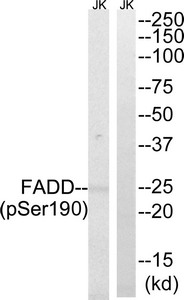
Western blot analysis of extracts from Jurkat cells treated with PMA using FADD (Phospho-Ser190) Antibody.The lane on the right is treated with the antigen-specific peptide.
Phospho-FADD (Ser191) Antibody
CSB-PA446731
ApplicationsWestern Blot, ELISA, ImmunoHistoChemistry
Product group Antibodies
ReactivityHuman, Mouse
TargetFADD
Overview
- SupplierCusabio
- Product NamePhospho-FADD (Ser191) Antibody
- Delivery Days Customer20
- ApplicationsWestern Blot, ELISA, ImmunoHistoChemistry
- CertificationResearch Use Only
- ClonalityPolyclonal
- ConjugateUnconjugated
- Gene ID8772
- Target nameFADD
- Target descriptionFas associated via death domain
- Target synonymsFas (TNFRSF6)-associated via death domain; FAS-associated death domain protein; Fas-associating death domain-containing protein; Fas-associating protein with death domain; GIG3; growth-inhibiting gene 3 protein; mediator of receptor-induced toxicity; MORT1
- HostRabbit
- IsotypeIgG
- Protein IDQ13158
- Protein NameFAS-associated death domain protein
- Scientific DescriptionThe protein encoded by this gene is an adaptor molecule that interacts with various cell surface receptors and mediates cell apoptotic signals. Through its C-terminal death domain, this protein can be recruited by TNFRSF6/Fas-receptor, tumor necrosis factor receptor, TNFRSF25, and TNFSF10/TRAIL-receptor, and thus it participates in the death signaling initiated by these receptors. Interaction of this protein with the receptors unmasks the N-terminal effector domain of this protein, which allows it to recruit caspase-8, and thereby activate the cysteine protease cascade. Knockout studies in mice also suggest the importance of this protein in early T cell development. Sugano S., Nat. Genet. 36:40-45(2004). Farmer A., Submitted (MAY-2003). Venter J.C., Submitted (JUL-2005).
- ReactivityHuman, Mouse
- Storage Instruction-20°C or -80°C
- UNSPSC12352203

